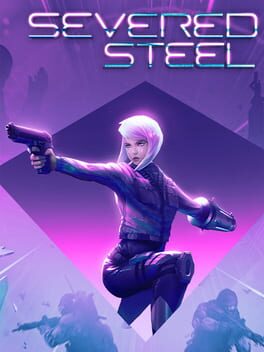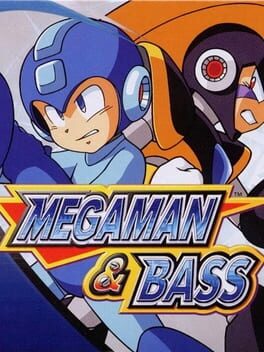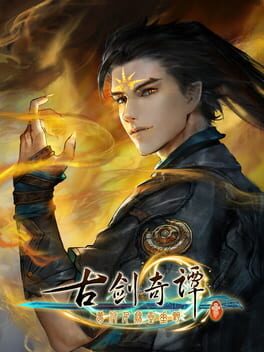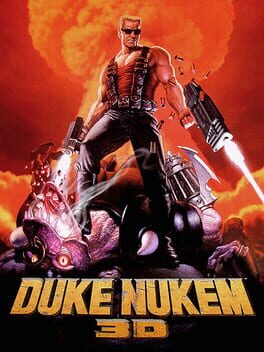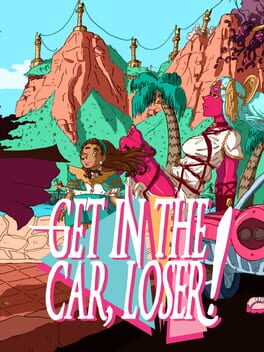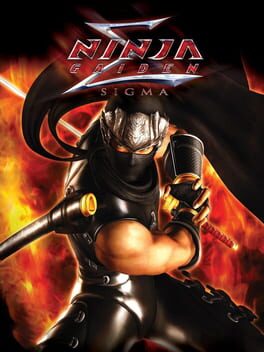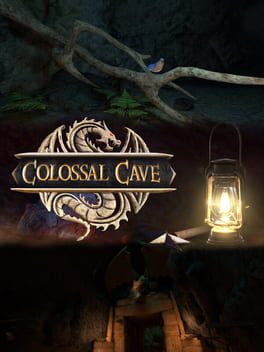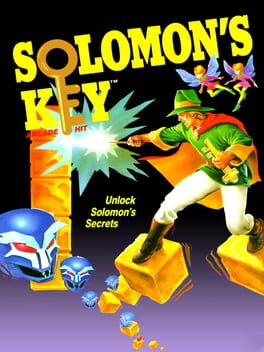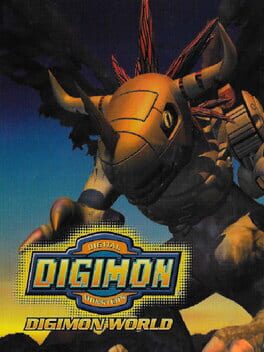rubenmg
The best parts are when the main character feels bad for just going out because her mother has been waiting all night. Being a really small thing, it nails that the guilt is not so much on how the mother really feels, but on the girl’s perceptions on how she always thought she ought to be (as expected, it turns out that it is not that much of a deal, although the game is also too bland presenting the conflict of views and needs between mother and daughter).
Getting that out of the way, the game lacks passion. The same passion that makes the girl want to change her life to be who she really is, that makes her fall in love, that makes her take risks. I even activated the “erotic” scenes out of curiosity (because I’m a pervert) and I’m pretty sure I can easily find Teletubbies clips with more blood in their veins than any sexual encounter here, let alone any kiss or any hug. And this is not only my complaint about the relationship not working but about the exploration of oneself necessities and desires not working, about the state (and problems) of living in Hong Kong in 1986 being whatever and at the end getting out with a bland, supposedly liberating, romance that is too shy to say anything out loud as much as it wants to.
Getting that out of the way, the game lacks passion. The same passion that makes the girl want to change her life to be who she really is, that makes her fall in love, that makes her take risks. I even activated the “erotic” scenes out of curiosity (because I’m a pervert) and I’m pretty sure I can easily find Teletubbies clips with more blood in their veins than any sexual encounter here, let alone any kiss or any hug. And this is not only my complaint about the relationship not working but about the exploration of oneself necessities and desires not working, about the state (and problems) of living in Hong Kong in 1986 being whatever and at the end getting out with a bland, supposedly liberating, romance that is too shy to say anything out loud as much as it wants to.
2021
There is always a sensation that you are on the verge of being overwhelmed by the game, but due to how short term the weapons are, the focus on getting close to single objectives helps as a guidance to lead your havoc to. The delicious core mechanics could only carry the game so far, but the fast paced campaign keeps throwing more and more good ideas into the mix (save for some few uninspired levels at the end). Portals, flying enemies that rival your mobility, shielded soldiers that will push you to prove that yes, flipping your character vertically in first person is cool, all you needed was to move the camera manually during bullet time to make it work.
And the environments themselves, how everything is so small to make you feel trapped but at the same time open enough so that 12 guys will shoot you from any direction the second you enter a new room. Really the only thing I’m missing here is that enemies would be more mixed up, the different types are already there after all, if only to ramp up the scenery destruction, the most notable footprint after the battle. But even when the most basic soldiers are a bit too abundant, their AI ensures that they are never a passive obstacle. You never stay still, why would they wait for you then. The only way to escape is to keep moving.
And the environments themselves, how everything is so small to make you feel trapped but at the same time open enough so that 12 guys will shoot you from any direction the second you enter a new room. Really the only thing I’m missing here is that enemies would be more mixed up, the different types are already there after all, if only to ramp up the scenery destruction, the most notable footprint after the battle. But even when the most basic soldiers are a bit too abundant, their AI ensures that they are never a passive obstacle. You never stay still, why would they wait for you then. The only way to escape is to keep moving.
1998
Occasionally while playing this, I wished that a giant hand appeared in the middle of the screen. It would shake the current level, spin it, slap it, perform a first aid CPR, just to see if the game could exhale the slightest of the breaths or to try and hear the quietest heartbeat.
This never happens and rigidness reigns supreme. The holy unwritten book with the golden rules on how to make a Megaman is religiously followed. And you know those rules don’t work when something as the appearing blocks become a trademark of the series. When you ask these games to shake things up they respond: this is how Megaman games were done in the 80s, in the 90s and in the next thousand years. The robot that produces endless sequels for the infinite Megaman flavors struggles with entry data from the outside, only capable of generating new infinite subseries when this phenomenon occurs. Megaman games are only fed with other Megaman games.
And here we have the blue guy, he even brought a friend this time. They don't do too much, but they would like to do less. Running, jumping, sliding, shooting, everything seems boring to them, despite the honesty that could be considered in their simplicity. The enemies appear to be just as uninterested. When they throw an occasional weird behaviour into their being they don't last before remembering their work. Be a by the book obstacle and drop a reward when beaten. Everytime that we kill one of these it seems like they want us to beat the level more than ourselves, asking to please never respawn them again. They even give us better rewards each time that we kill them!
The cruel response to this plea from the developers is pushing you back with some checkpoints and making you do the whole level again if you run out of lives. I don't have a problem with repeating stuff. But if the first time going through a level is already uninteresting it's an easy guess how the 10th time will be. If anything, while cursing whoever made these dead levels, at least I dedicate my prayers to whoever invented savestates.
This never happens and rigidness reigns supreme. The holy unwritten book with the golden rules on how to make a Megaman is religiously followed. And you know those rules don’t work when something as the appearing blocks become a trademark of the series. When you ask these games to shake things up they respond: this is how Megaman games were done in the 80s, in the 90s and in the next thousand years. The robot that produces endless sequels for the infinite Megaman flavors struggles with entry data from the outside, only capable of generating new infinite subseries when this phenomenon occurs. Megaman games are only fed with other Megaman games.
And here we have the blue guy, he even brought a friend this time. They don't do too much, but they would like to do less. Running, jumping, sliding, shooting, everything seems boring to them, despite the honesty that could be considered in their simplicity. The enemies appear to be just as uninterested. When they throw an occasional weird behaviour into their being they don't last before remembering their work. Be a by the book obstacle and drop a reward when beaten. Everytime that we kill one of these it seems like they want us to beat the level more than ourselves, asking to please never respawn them again. They even give us better rewards each time that we kill them!
The cruel response to this plea from the developers is pushing you back with some checkpoints and making you do the whole level again if you run out of lives. I don't have a problem with repeating stuff. But if the first time going through a level is already uninteresting it's an easy guess how the 10th time will be. If anything, while cursing whoever made these dead levels, at least I dedicate my prayers to whoever invented savestates.
2018
How interesting are the inhabited places. It is very easy to be impressed with the celestial aesthetic of the first city you visit, present both in the habitants clothes and also in the impossible colossal architecture, where air-sustained bridges envelop the monumental buildings with their curves. It is even more impressive that when you go to the human world the villages are even more interesting.
Contrary to some trends in RPGs, you get to know the life of a place not by intruding into other peoples houses, but just by contemplating their lives on the outside. What better occasion to know the customs of a new place than with a street market. A market that isn’t there for you, you can’t “interact” with most of the shops because you don’t need to. There you can see people gathering together doing some errands, some workers a bit farther away in the beautiful process of paint manufacturing, an old man telling riddles to little kids… Looking a bit more into it, it’s not just the people, but how the villages are very intelligently built around water. You have this first village that surrounds the side of a lake or the second one with an aqueduct system that provides a stream of water around all the houses.
But this is a fantasy RPG or something, so the inevitable time of adventure will come sooner or later. Where the villages irradiated charm just by showing how life went on in a natural way, the adventure sections are unable to hide their blatant lies even when they are set in a forest. The repetitive punchless combats, the uninteresting streamlined levels, the puzzles to add “variety”... This is, unfortunately, the focus of the game, what I mentioned before is a complement at most.
Contrary to some trends in RPGs, you get to know the life of a place not by intruding into other peoples houses, but just by contemplating their lives on the outside. What better occasion to know the customs of a new place than with a street market. A market that isn’t there for you, you can’t “interact” with most of the shops because you don’t need to. There you can see people gathering together doing some errands, some workers a bit farther away in the beautiful process of paint manufacturing, an old man telling riddles to little kids… Looking a bit more into it, it’s not just the people, but how the villages are very intelligently built around water. You have this first village that surrounds the side of a lake or the second one with an aqueduct system that provides a stream of water around all the houses.
But this is a fantasy RPG or something, so the inevitable time of adventure will come sooner or later. Where the villages irradiated charm just by showing how life went on in a natural way, the adventure sections are unable to hide their blatant lies even when they are set in a forest. The repetitive punchless combats, the uninteresting streamlined levels, the puzzles to add “variety”... This is, unfortunately, the focus of the game, what I mentioned before is a complement at most.
1996
A bridge between the abstract action labyrinths of Doom and the future more cohesive places of the genre like Half Life, Duke Nukem 3D just occasionally reaches anything interesting on either side or on their union. With a much less combat focused than usual approach (enemies having 101 shooter design, most interesting situations relying on traps and thus in item usage and environment awareness to get around them) the game leans toward more of a navigational puzzle. Which is not something that different from the pure labyrinth that was Wolfenstein 3D to begin with, with the difference that the Duke is searching for a less gamey sense of place.
At first, the trick doesn’t work that bad since the attention to detail (in decorative interactions particularly) does give the illusion of a more sophisticated approach to what even a level is. However, this same illusion turns on itself when the exploration is forced and, when actively asked to pay attention to the map, the gamey sense is stronger than the most obvious lazy Doom arena, at least those were coherent inside their own logic. The real places start being small, forgettable samples among a greater, not that good navigational chaos.
Moreover, it seems that there is a conflict of wanting to avoid plaguing everything with action, worrying that it would detriment the contemplative approach to understand the level on a logical level, when a year later Blood would demonstrate that taking more cohesive, less abstract places as inspiration while maintaining the usual level of adrenaline everywhere resulted, even though similar to a theme park, in an unmistakably felt sense of a cohesive place.
At first, the trick doesn’t work that bad since the attention to detail (in decorative interactions particularly) does give the illusion of a more sophisticated approach to what even a level is. However, this same illusion turns on itself when the exploration is forced and, when actively asked to pay attention to the map, the gamey sense is stronger than the most obvious lazy Doom arena, at least those were coherent inside their own logic. The real places start being small, forgettable samples among a greater, not that good navigational chaos.
Moreover, it seems that there is a conflict of wanting to avoid plaguing everything with action, worrying that it would detriment the contemplative approach to understand the level on a logical level, when a year later Blood would demonstrate that taking more cohesive, less abstract places as inspiration while maintaining the usual level of adrenaline everywhere resulted, even though similar to a theme park, in an unmistakably felt sense of a cohesive place.
Act I is good vibes: the videogame. That doesn’t mean that it lacks claws, it’s about a journey against obvious fascist, homophobe, transphobe and related figures and ideologies. The game doesn’t even try to hide who is fighting against, and it’s the right call, it would be a bit of a step down to look for some supposed “subtlety” in a game that yearns for justice, or at least the fantasy of it. What’s good is that, having clear who is the enemy, the group just goes by, drive and kick ass, chilling. Realizing on the car that a mysterious godly giant bird is following them and insulting it just in case that it is omnipresent, finishing every combat with a postal card goofy photo, turning the whole screen pink as Grace prepares freezed while “I WON’T FALTER IN THE FACE OF EVIL” is written on giant scratched letters across the screen when the Sword of Fate is used, the escape combat option asking you if you want to “escape to fight another day”, the result screen after escaping telling you that “the only reward for running from a fight is survival”... Even the too repetitive combats get a pass by being mostly avoidable (not exactly a compliment, I know) and being very active, without pauses.
This energy is lost entering act II onwards. The now not tutorialized combat shows that it doesn't take off, worsened by an even more insisting encounter pace. The little cute details get caught too in repetition and lose their significance soon. Probably the worst one, the carefree talk on the road is now drained by thoughts about how the villains view them, when not the villains doing the monologues themselves, what before asked to be responded with a fist in the mouth now takes its time to fade away the charm. But this does come to some sense.
If I don’t care about any lack of subtlety is because one of the things I appreciate the most, in general, is honesty. Not that being honest is always enough, but I feel that I need some of it if only to be on the basis. Act III, the more direct one, takes the hateful villain ideas and explores how it affects Sam along the way in full introspection. An exploration that is clunky, not only for the still present combat, now being more disruptive than before, but also the constant humor not being in place at all and the overall presentation forgetting about the senses. Yet, I appreciate the pause to explore the doubts and fears of a queer hero, insecurities that for sure have been discussed way too many times before and probably better, and still a sincere action above all. If this queer battle wants to take any chance to win it must fight nihilism as well. Against the “nothing really matters”, care about the individual. Random people posting online that you should not exist and the likes are interesting subjects to care about as evident or small as they may seem, after all, those thoughts do come from somewhere real, and that's the frightening part. Is this confession then enough in spite of everything? Ironically, to be honest, I understand the soul, but I don't feel it as much.
This energy is lost entering act II onwards. The now not tutorialized combat shows that it doesn't take off, worsened by an even more insisting encounter pace. The little cute details get caught too in repetition and lose their significance soon. Probably the worst one, the carefree talk on the road is now drained by thoughts about how the villains view them, when not the villains doing the monologues themselves, what before asked to be responded with a fist in the mouth now takes its time to fade away the charm. But this does come to some sense.
If I don’t care about any lack of subtlety is because one of the things I appreciate the most, in general, is honesty. Not that being honest is always enough, but I feel that I need some of it if only to be on the basis. Act III, the more direct one, takes the hateful villain ideas and explores how it affects Sam along the way in full introspection. An exploration that is clunky, not only for the still present combat, now being more disruptive than before, but also the constant humor not being in place at all and the overall presentation forgetting about the senses. Yet, I appreciate the pause to explore the doubts and fears of a queer hero, insecurities that for sure have been discussed way too many times before and probably better, and still a sincere action above all. If this queer battle wants to take any chance to win it must fight nihilism as well. Against the “nothing really matters”, care about the individual. Random people posting online that you should not exist and the likes are interesting subjects to care about as evident or small as they may seem, after all, those thoughts do come from somewhere real, and that's the frightening part. Is this confession then enough in spite of everything? Ironically, to be honest, I understand the soul, but I don't feel it as much.
2008
It is nice that there is a store management component and that you have to adapt to your clients to force yourself into seeing fashion with other eyes, out of your comfort zone and adding charisma to the different customers along the way. After all, if it was more of a toy where you simply dress your custom character as desired since the very beginning, in the hopes of fulfilling a sort of dressing freedom, it would struggle to compete against the at the time already plentiful online dress up games and, specially considering children as the target audience in mind, simply drawing characters and their looks with literal boundless possibilities and references to borrow inspiration from.
The management of the shop is also thought less as a strategy game and more about having a bit of everything in reserve to please everyone. To please not because of clients being walking cash bags (the monetary aspect is so irrelevant that the game will give you funds for free if you somehow get close to being broke) but because of an honest intent to see them as characters, mostly defined by their stylistic preferences. They have their little backgrounds and will even ask you to hang out when enough confidence is built, it is a communication exercise by understanding them through fashion.
Having said that, there is something missing around there. Serving your customers becomes tedious, even when the requests try to be varied, and these same people that the game wanted you to care about individually become a certain mass of tasks to complete to get to the next shop ranking to get to the next fashion contest to eventually get the credits rolling. A disheartening, although perhaps accurate, depiction of the job and the career, a subconscious design output never addressed nonetheless.
My view may be wrong, since the game will continue living on long after you win whatever you want to win, yet somehow it seems trapped between two extremes. One can just wonder if it could have been better by compromising either with being a relaxed game to check once in a while without pressure, just out of sheer interest, or a more mechanically asking game, perhaps even taking more fantastic approaches to present an active challenge while making you care about fashion.
Or maybe I am resentful and envious that women have better style possibilities.
The management of the shop is also thought less as a strategy game and more about having a bit of everything in reserve to please everyone. To please not because of clients being walking cash bags (the monetary aspect is so irrelevant that the game will give you funds for free if you somehow get close to being broke) but because of an honest intent to see them as characters, mostly defined by their stylistic preferences. They have their little backgrounds and will even ask you to hang out when enough confidence is built, it is a communication exercise by understanding them through fashion.
Having said that, there is something missing around there. Serving your customers becomes tedious, even when the requests try to be varied, and these same people that the game wanted you to care about individually become a certain mass of tasks to complete to get to the next shop ranking to get to the next fashion contest to eventually get the credits rolling. A disheartening, although perhaps accurate, depiction of the job and the career, a subconscious design output never addressed nonetheless.
My view may be wrong, since the game will continue living on long after you win whatever you want to win, yet somehow it seems trapped between two extremes. One can just wonder if it could have been better by compromising either with being a relaxed game to check once in a while without pressure, just out of sheer interest, or a more mechanically asking game, perhaps even taking more fantastic approaches to present an active challenge while making you care about fashion.
Or maybe I am resentful and envious that women have better style possibilities.
Somehow similar to GTA III in how it takes its open world condition. The first impression may differ from this view, the New York life one tried to communicate with tons of NPCs on screen doing nothing in particular contrasts with the desertic Mars where everyone seems to be either a worker or a cop. However, upon tackling the action it’s another story.
Except for a few more gimmicky missions, that are the lowest points, Red Faction Guerrilla unifies in harmony its objectives and its chaotic systems. To kill a sniper you can search for their exact location or you can just demolish the whole building they are in. What makes the game fun all throughout is that the messy behavior of each system piles up to give interesting situations constantly. You can enter a fortress by searching for the entrance or you can just hammer your way in. Better yet, pick up a good vehicle, build speed and crash through any wall. Similarly, the way the enemy and ally reinforcements join the multiple battles keep giving a persistent sense of life that adds to the destructive nature of the game as war wages while everything gets demolished in the way.
There are just some impressive, probably even unwanted, details due to being consistent with the open world and its physical presence. From the slapstick comedic tragedy of seeing the building you just took the pillars off crumbling you into death, as many years of Minecraft made us forget about gravity, to keep seeing how alerts for enemy buildings being destroyed pop up while on a mission and realizing that, at least just for a bit, somewhere out of there the world is still alive and reacting even if you’re not watching.
Except for a few more gimmicky missions, that are the lowest points, Red Faction Guerrilla unifies in harmony its objectives and its chaotic systems. To kill a sniper you can search for their exact location or you can just demolish the whole building they are in. What makes the game fun all throughout is that the messy behavior of each system piles up to give interesting situations constantly. You can enter a fortress by searching for the entrance or you can just hammer your way in. Better yet, pick up a good vehicle, build speed and crash through any wall. Similarly, the way the enemy and ally reinforcements join the multiple battles keep giving a persistent sense of life that adds to the destructive nature of the game as war wages while everything gets demolished in the way.
There are just some impressive, probably even unwanted, details due to being consistent with the open world and its physical presence. From the slapstick comedic tragedy of seeing the building you just took the pillars off crumbling you into death, as many years of Minecraft made us forget about gravity, to keep seeing how alerts for enemy buildings being destroyed pop up while on a mission and realizing that, at least just for a bit, somewhere out of there the world is still alive and reacting even if you’re not watching.
2007
(Played the PC version that isn’t exactly the same as Sigma as far as I know)
The first time you take control you are already in a battle. No button prompts, no combos explained, just smash the controller, play, discover, have fun. If somebody told me they did the Mario 64 thing of not developing a proper game until the main character felt amazing to play in an empty box I would believe it. This is so playful that, despite feeling designed to be able to go through with your first weapon only, they throw like a dozen of them more, why not, more toys.
There is no good action game with a moveset only, and the first 3 chapters of the game make sure to demonstrate how to make a top action game. The first common enemies are ninjas resembling Ryu, and will hunt his ass at every chance, actively and reactively. Not only will the enemies keep retaliating, but the surroundings will raise the tension too. In here constrained spaces have a special meaning, since yes, you are surrounded with deadly ninjas, but you are a ninja yourself, use that wall on your back and jump on it, run on it, redefine 3D action. And it doesn’t stop there, enemies won’t be waiting sitting, turning a corner could be a potential trap with a guy backflipping his sword towards your neck. The game even manages to play with your expectations, there is a section in chapter 3 where after killing some dudes from a distance you have to go where they were totally defenseless, with a single potential hit sending you to the void.
What is in chapter 4 and beyond then? The game losing inspiration. As new enemies are needed to keep the action fresh, ideas struggle. The most conventional enemies that supposed a big threat not long ago begin to be dispatched easily as a routine, expected after fighting the same guys a hundred times and with less challenging environments in every iteration. Worse than that, some demons seem to be incapable of holding up with Ryu’s incredible speed.
But when the game totally runs out of gas is at the middle of chapter 7. In here there is a scene where Ryu accidentally activates a curse. We see the dead rising, really big zombies accompanied by really big weapons. So, what is the defining characteristic of these guys that want to kill our lightspeed moving character so bad? That they move slowly. Like really slow, the slowest enemy that I can think of in any action game ever. It would pose some threat if you had to fight like surrounded by 10 of them I guess, but since this is the only time in the game where you can relax and prepare as many fully charged attacks as you want, Ryu’s deadliest technique, they just walk very slowly towards their death. Fortunately, after many endless fights with those guys, they stop appearing, but it has been made evident that inspiration is totally gone.
For the remaining 12 chapters, apart from bosses that already ranged from bad to very bad, the game introduces: bad first person shooting sections, bad water sections and even a bad 3D Zelda inspired dungeon gets its place too. Meanwhile some of the best new enemies are, new versions of old enemies but weaker? The best thing that can be said about the new things that keep being added desperately is that they don’t last too long, but a continuous sequence of the same lack of inspiration ends up tiring the same way.
I like how the game moves, a lot. I'm even thinking right now of playing again when I know that I will be let down after a few minutes. I just wish that the game constructed around such a character was just as good.
The first time you take control you are already in a battle. No button prompts, no combos explained, just smash the controller, play, discover, have fun. If somebody told me they did the Mario 64 thing of not developing a proper game until the main character felt amazing to play in an empty box I would believe it. This is so playful that, despite feeling designed to be able to go through with your first weapon only, they throw like a dozen of them more, why not, more toys.
There is no good action game with a moveset only, and the first 3 chapters of the game make sure to demonstrate how to make a top action game. The first common enemies are ninjas resembling Ryu, and will hunt his ass at every chance, actively and reactively. Not only will the enemies keep retaliating, but the surroundings will raise the tension too. In here constrained spaces have a special meaning, since yes, you are surrounded with deadly ninjas, but you are a ninja yourself, use that wall on your back and jump on it, run on it, redefine 3D action. And it doesn’t stop there, enemies won’t be waiting sitting, turning a corner could be a potential trap with a guy backflipping his sword towards your neck. The game even manages to play with your expectations, there is a section in chapter 3 where after killing some dudes from a distance you have to go where they were totally defenseless, with a single potential hit sending you to the void.
What is in chapter 4 and beyond then? The game losing inspiration. As new enemies are needed to keep the action fresh, ideas struggle. The most conventional enemies that supposed a big threat not long ago begin to be dispatched easily as a routine, expected after fighting the same guys a hundred times and with less challenging environments in every iteration. Worse than that, some demons seem to be incapable of holding up with Ryu’s incredible speed.
But when the game totally runs out of gas is at the middle of chapter 7. In here there is a scene where Ryu accidentally activates a curse. We see the dead rising, really big zombies accompanied by really big weapons. So, what is the defining characteristic of these guys that want to kill our lightspeed moving character so bad? That they move slowly. Like really slow, the slowest enemy that I can think of in any action game ever. It would pose some threat if you had to fight like surrounded by 10 of them I guess, but since this is the only time in the game where you can relax and prepare as many fully charged attacks as you want, Ryu’s deadliest technique, they just walk very slowly towards their death. Fortunately, after many endless fights with those guys, they stop appearing, but it has been made evident that inspiration is totally gone.
For the remaining 12 chapters, apart from bosses that already ranged from bad to very bad, the game introduces: bad first person shooting sections, bad water sections and even a bad 3D Zelda inspired dungeon gets its place too. Meanwhile some of the best new enemies are, new versions of old enemies but weaker? The best thing that can be said about the new things that keep being added desperately is that they don’t last too long, but a continuous sequence of the same lack of inspiration ends up tiring the same way.
I like how the game moves, a lot. I'm even thinking right now of playing again when I know that I will be let down after a few minutes. I just wish that the game constructed around such a character was just as good.
Even though more lenient in the individual relationship management, the Girl’s Side of Tokimeki Memorial still carries the stressful view on high school romance centered life that the original one had. Some new ideas are introduced, such as being able to choose your clothes for every date and having to manage money to buy such clothes, and every single one of them still contributes to making this period of life a stressful strategic one.
And to sympathize with the motives is not that hard. Tokimeki always saw those teenage years as a period where every decision you took mattered towards how others perceived you, and to feel like you are about to make the wrong move all the time. For this reason, dates are not really interesting for what they are (if you go to a concert, the performance itself is skipped, if you go bowling, the game itself is skipped) because what matters is the actions you decide to take and the response of your romantic interest.
The consequence of this is immediate, romance is turned into a strategy game not that far from keeping your relationships healthy in Crusader Kings. Love is war, they say. And while it doesn’t necessarily mean to be a worthless approach, it doesn’t quite succeed.
The strategic elements end up being quite simple because of two reasons. First, it’s based on repeating a routine and keeping an eye out for obvious dangerous scenarios (bombs), it ends up lacking depth and because of the hard coded "victory" conditions you either know exactly how to succeed in a particular relationship or you don’t have a clue. Secondly, and most decisively, all the boys (...or men…) are boring at best and a hazard to avoid at worst. Perhaps the strategic options would carry more weight if you truly cared who you would end up falling in love with, but because of the game philosophy deciding to prioritize the cold strategy over the warm heartfelt moments the stakes are never there.
There is one notable exception regarding the disinterest towards any relationship. Turns out that in this game you can have up to four female friends that, precisely because you get to know them through random events that just occur and not through dates where you need to ponder what your optimal actions are, end up being genuine charismatic relationships. You see some friends hanging around having a good time and wish to be with them, you go on a school trip and the first one to get your back will be that girl from your club you read fashion magazines with during the week. The game seems to recognize the quality that it rejects by giving you a friendship ending option where you end up with the people that you truly cared about during all of these three years. Of course, with romance out of the question.
https://www.youtube.com/watch?v=LK8WOxVpsNc
And to sympathize with the motives is not that hard. Tokimeki always saw those teenage years as a period where every decision you took mattered towards how others perceived you, and to feel like you are about to make the wrong move all the time. For this reason, dates are not really interesting for what they are (if you go to a concert, the performance itself is skipped, if you go bowling, the game itself is skipped) because what matters is the actions you decide to take and the response of your romantic interest.
The consequence of this is immediate, romance is turned into a strategy game not that far from keeping your relationships healthy in Crusader Kings. Love is war, they say. And while it doesn’t necessarily mean to be a worthless approach, it doesn’t quite succeed.
The strategic elements end up being quite simple because of two reasons. First, it’s based on repeating a routine and keeping an eye out for obvious dangerous scenarios (bombs), it ends up lacking depth and because of the hard coded "victory" conditions you either know exactly how to succeed in a particular relationship or you don’t have a clue. Secondly, and most decisively, all the boys (...or men…) are boring at best and a hazard to avoid at worst. Perhaps the strategic options would carry more weight if you truly cared who you would end up falling in love with, but because of the game philosophy deciding to prioritize the cold strategy over the warm heartfelt moments the stakes are never there.
There is one notable exception regarding the disinterest towards any relationship. Turns out that in this game you can have up to four female friends that, precisely because you get to know them through random events that just occur and not through dates where you need to ponder what your optimal actions are, end up being genuine charismatic relationships. You see some friends hanging around having a good time and wish to be with them, you go on a school trip and the first one to get your back will be that girl from your club you read fashion magazines with during the week. The game seems to recognize the quality that it rejects by giving you a friendship ending option where you end up with the people that you truly cared about during all of these three years. Of course, with romance out of the question.
https://www.youtube.com/watch?v=LK8WOxVpsNc
2023
While a direct translation to 3D of a game that just with the title “Colossal Cave Adventure” is an evident good idea, the too literally attached attempt to homage the original weighs down the experience.
As expected, the huge cave is wonderfully modeled, just as the hazy original text suggested, to maintain an overwhelming first impression. In the lack of confidence of pure exploration, also known as pure adventure, the original ended up being turned into a long term strategy game where to plan out your movements according to illogical trial and error procedures discovered in previous playthroughs. An abandonment of genuine geographical/magical discovery for a more bland, gamey repetition exercise.
This remake not only maintains the exact same problem, but adds a couple of its own when the senseless non-geographical elements need to be translated. Moments that still felt genuine in the original like the pirate or the dwarves appearing out of nowhere didn't need an explanation because of the turn based text narration abstraction itself. This, now in a literal 3D representation, means that these same characters appear and disappear out of magical smoke as you get paralyzed waiting for them to mess with you. This also applies to some of the puzzles. It happens in the puzzles that retained some sense, like being unable to carry the gold nugget to an upper floor, here being contradicted by the floors being separated explicitly with samey stairs in which some arbitrarily allow you to carry the gold and some others not. And it happens in the puzzles that didn’t make that much sense, the spatially impossible labyrinths may get a pass because of the inevitable omissions of text narration nature, but here it is just an unacceptable same looking room where the obvious loading screens magic trick just comes off as cheap.
Since there are obvious downsides to the literal transformation of the blandest parts in the original game, it would be nice to embrace the spatial twists and its own 3D geographical nature in all its glory without additives. What a coincidence that the “adventure” part was dropped from the title.
As expected, the huge cave is wonderfully modeled, just as the hazy original text suggested, to maintain an overwhelming first impression. In the lack of confidence of pure exploration, also known as pure adventure, the original ended up being turned into a long term strategy game where to plan out your movements according to illogical trial and error procedures discovered in previous playthroughs. An abandonment of genuine geographical/magical discovery for a more bland, gamey repetition exercise.
This remake not only maintains the exact same problem, but adds a couple of its own when the senseless non-geographical elements need to be translated. Moments that still felt genuine in the original like the pirate or the dwarves appearing out of nowhere didn't need an explanation because of the turn based text narration abstraction itself. This, now in a literal 3D representation, means that these same characters appear and disappear out of magical smoke as you get paralyzed waiting for them to mess with you. This also applies to some of the puzzles. It happens in the puzzles that retained some sense, like being unable to carry the gold nugget to an upper floor, here being contradicted by the floors being separated explicitly with samey stairs in which some arbitrarily allow you to carry the gold and some others not. And it happens in the puzzles that didn’t make that much sense, the spatially impossible labyrinths may get a pass because of the inevitable omissions of text narration nature, but here it is just an unacceptable same looking room where the obvious loading screens magic trick just comes off as cheap.
Since there are obvious downsides to the literal transformation of the blandest parts in the original game, it would be nice to embrace the spatial twists and its own 3D geographical nature in all its glory without additives. What a coincidence that the “adventure” part was dropped from the title.
2017
Though it’s obviously easy to share the sentiment, all the commentary about corporations taking upon death itself is rather weak. It points out what is certainly happening everywhere, but with an ending dictated with too much of a good heart without thinking about the consequences of actually taking the risk it comes off as naive. The preparation of the deceased through a simple puzzley segment, especially in the cremation process, the stay positive mail list and overall cuteness are probably not the best fit for most of the situations. Yet, there is something in there.
Though simplified as it may be, having to actually prepare each of the deceased gives a bit more insight into the process and labor of a mortician. The mails give new perspectives about death and how to deal with it, sometimes obvious and not that interesting, true, but sometimes hitting the right spot (“Religion provides different paths for dealing with a death, but the goal is almost always the same: offering support, guidance, and ease to the people who are grieving”). Even that cute aesthetic helps to make the process more mundane, in a good sense, considering we are in the perspective of the mortician. But not without respect.
If the game ended up gaining me it was due to the sections where you have to attend the funerals. Due to the protagonist being silent (even if she is implied to communicate at least via email), her role is as simple as necessary, just lending an ear. And not everyone will grieve the same, some will be unable to speak in tears, some will think about if things couldn't have gone differently, some put their mind on how to distract themselves to make it easier… Most importantly, there is one thing that Charlotte will always do before leaving, no matter the complications behind the bureaucracy, including that certain peculiar funeral. She will always bid farewell with a reverence.
Though simplified as it may be, having to actually prepare each of the deceased gives a bit more insight into the process and labor of a mortician. The mails give new perspectives about death and how to deal with it, sometimes obvious and not that interesting, true, but sometimes hitting the right spot (“Religion provides different paths for dealing with a death, but the goal is almost always the same: offering support, guidance, and ease to the people who are grieving”). Even that cute aesthetic helps to make the process more mundane, in a good sense, considering we are in the perspective of the mortician. But not without respect.
If the game ended up gaining me it was due to the sections where you have to attend the funerals. Due to the protagonist being silent (even if she is implied to communicate at least via email), her role is as simple as necessary, just lending an ear. And not everyone will grieve the same, some will be unable to speak in tears, some will think about if things couldn't have gone differently, some put their mind on how to distract themselves to make it easier… Most importantly, there is one thing that Charlotte will always do before leaving, no matter the complications behind the bureaucracy, including that certain peculiar funeral. She will always bid farewell with a reverence.
1986
There is some undeniable wit in its very own premise of being able to create and destroy (part of) the map at will as a puzzle solver tool, however, the strength of the premise never finds a worthy match in the design of any level.
Sure, there are enough smart elements to carry the game, but as the levels are formed into puzzle boxes they are underwhelming, with solutions usually taking about 3 or 4 not that clever steps to clear and few rearrangements of expectations within the given rules, more often than not, it feels like it has nothing to twist even. The worries of not being competent in following the premise intelligence are confirmed by the addition of the action elements.
If the puzzle game is well thought out at its premise, the same cannot be said about the action. At best, it will give a few surprises through exploration or luck, but it will often feel as a detriment in the way to make the game look more interesting. Sure, it's important to add a timer to twist a bit more what a possible solution can be, but, apart from that, action usually will mean just a mere transit (regardless of its difficulty to execute) between solving a level and discovering a new one. It seems even more clear looking at how the levels are thought out in a very tight tile distribution, and realizing that the time limit is just a real time, and less intellectually interesting, number of movements limit.
To envision Solomon's Key as a pure puzzle game is not only possible but a revelation that there might have been a better similar game and that the level design always falls behind what the premise suggests. Thinking about Solomon's Key as an action game, it’s just too stiff to stand on its own, even the jump, the only action with some uncertain momentum, is an easy tile distance calculation. And I’m afraid most of the time will be spent dealing with the latter type of game.
Sure, there are enough smart elements to carry the game, but as the levels are formed into puzzle boxes they are underwhelming, with solutions usually taking about 3 or 4 not that clever steps to clear and few rearrangements of expectations within the given rules, more often than not, it feels like it has nothing to twist even. The worries of not being competent in following the premise intelligence are confirmed by the addition of the action elements.
If the puzzle game is well thought out at its premise, the same cannot be said about the action. At best, it will give a few surprises through exploration or luck, but it will often feel as a detriment in the way to make the game look more interesting. Sure, it's important to add a timer to twist a bit more what a possible solution can be, but, apart from that, action usually will mean just a mere transit (regardless of its difficulty to execute) between solving a level and discovering a new one. It seems even more clear looking at how the levels are thought out in a very tight tile distribution, and realizing that the time limit is just a real time, and less intellectually interesting, number of movements limit.
To envision Solomon's Key as a pure puzzle game is not only possible but a revelation that there might have been a better similar game and that the level design always falls behind what the premise suggests. Thinking about Solomon's Key as an action game, it’s just too stiff to stand on its own, even the jump, the only action with some uncertain momentum, is an easy tile distance calculation. And I’m afraid most of the time will be spent dealing with the latter type of game.
2021
A game that is conscious about its shonen references but isn’t ashamed of them, rather uses their strength to irradiate the energy of being young. Rivals, superpowers and especially rebelling against what you are supposed to be and choosing who you want to be.
But that’s where the consciousness stops. Didn’t reflect too much about anime filler it seems. Something as crucial as the combat system is just sitting there. The most inanimate way to represent dodgeball, obviously blander with each filler encounter, but instead of rebuilding it from scratch, removing it, or at least reducing it, just more variations keep being added hoping to do the coverup. A juvenile talk about being yourself at the same time as it follows the rules of old just because of tradition.
But that’s where the consciousness stops. Didn’t reflect too much about anime filler it seems. Something as crucial as the combat system is just sitting there. The most inanimate way to represent dodgeball, obviously blander with each filler encounter, but instead of rebuilding it from scratch, removing it, or at least reducing it, just more variations keep being added hoping to do the coverup. A juvenile talk about being yourself at the same time as it follows the rules of old just because of tradition.
1999
As much as I find the world fun to explore, the journey is limited by locks in the form of combats, and the key to unlock them is a Digimon partner trained to be powerful enough. I’m not fond of the high percentage of recruitments to the village that are done through fighting, though I can accept the bit of nonsense of “punch me to make me enter into sense”, the combat where you only take a supporting sideline in a beetle-like match is interesting enough for me to accept the premise. The process to get there however is not that good.
As obscure as the result (not to mistake with the process) of the Digimon raising system wants to be, it still carries too much from a tamagotchi raising the stats origin to its detriment. Each life is a methodical visit to the gym and near optional combats against dummy enemies, do not mistake these samey creatures with the unique Digimon that are allowed to be convinced back into the city, with occasional pauses to cover life necessities devoid of the biggest unexpected surprises that will really forge a bond between partners. The experiences that will stand out can and do arise if you go out on adventure knowing little to nothing, aka what most players will do instinctively on a first try, but this wears off forcibly after a few hours because, as much as you want to push it, the combat locks with high enough numbers will ask you to take a sedentary routine until you figure out, and put to practice, how to get bigger enough numbers.
You basically have two options. First, you play the lottery by keeping the playthrough blind, hoping that you reach the evolution requirements. As a last resort, you look into a guide out of despair, staring into abyss upon finding out that the requirements are not only arbitrary, but quite often contradict the “great trainer” nature, although not as much as the partner nature considering how mistreating or spoiling a Digimon is just another valid way to evolve them. Again, it’s a matter of raising the right numbers, without caring that they represent unhappiness, lack of discipline, caring mistakes or overfeeding/lack of proper feed in order to reach a desired unnatural weight. Either way, the result is that a few hours long light adventure transforms into a few dozen hours long hitting the train button simulator and a few illogical steps more if you peeked at the system behind.
For a game where a kid is brought on to reunite and revive a lost island with his juvenile innocent spirit, the progression forces you a bit too much to take a conservative and cold process towards treating your partner and your way to get through the problems of the world.
As obscure as the result (not to mistake with the process) of the Digimon raising system wants to be, it still carries too much from a tamagotchi raising the stats origin to its detriment. Each life is a methodical visit to the gym and near optional combats against dummy enemies, do not mistake these samey creatures with the unique Digimon that are allowed to be convinced back into the city, with occasional pauses to cover life necessities devoid of the biggest unexpected surprises that will really forge a bond between partners. The experiences that will stand out can and do arise if you go out on adventure knowing little to nothing, aka what most players will do instinctively on a first try, but this wears off forcibly after a few hours because, as much as you want to push it, the combat locks with high enough numbers will ask you to take a sedentary routine until you figure out, and put to practice, how to get bigger enough numbers.
You basically have two options. First, you play the lottery by keeping the playthrough blind, hoping that you reach the evolution requirements. As a last resort, you look into a guide out of despair, staring into abyss upon finding out that the requirements are not only arbitrary, but quite often contradict the “great trainer” nature, although not as much as the partner nature considering how mistreating or spoiling a Digimon is just another valid way to evolve them. Again, it’s a matter of raising the right numbers, without caring that they represent unhappiness, lack of discipline, caring mistakes or overfeeding/lack of proper feed in order to reach a desired unnatural weight. Either way, the result is that a few hours long light adventure transforms into a few dozen hours long hitting the train button simulator and a few illogical steps more if you peeked at the system behind.
For a game where a kid is brought on to reunite and revive a lost island with his juvenile innocent spirit, the progression forces you a bit too much to take a conservative and cold process towards treating your partner and your way to get through the problems of the world.

